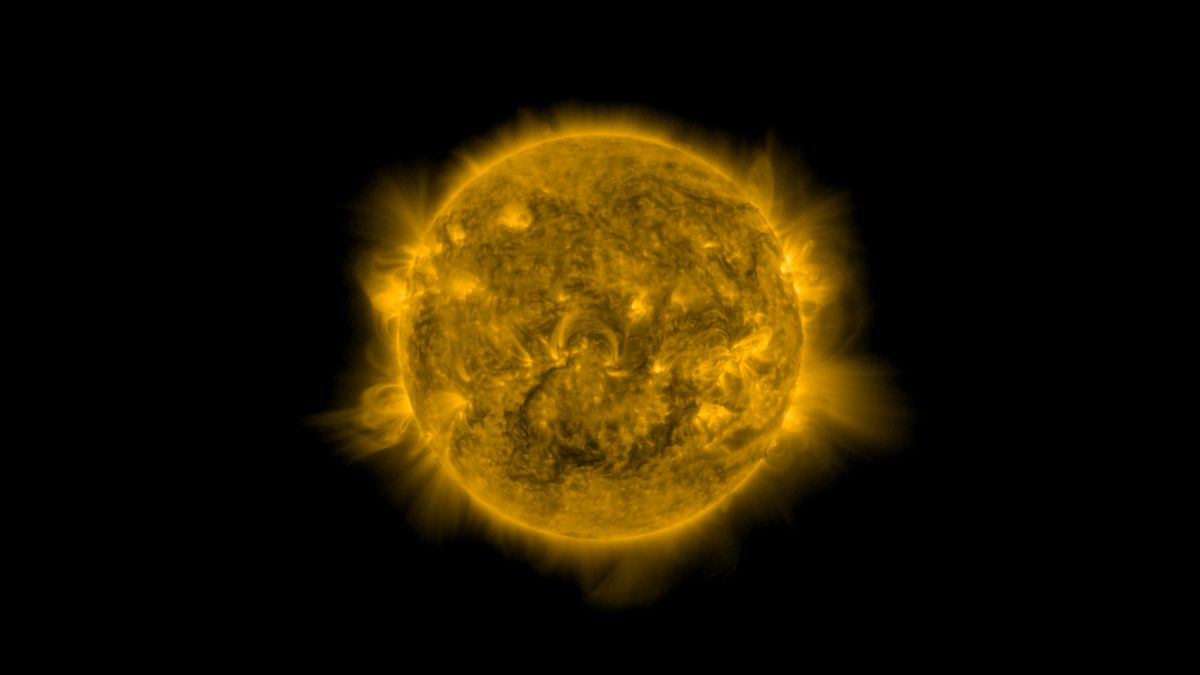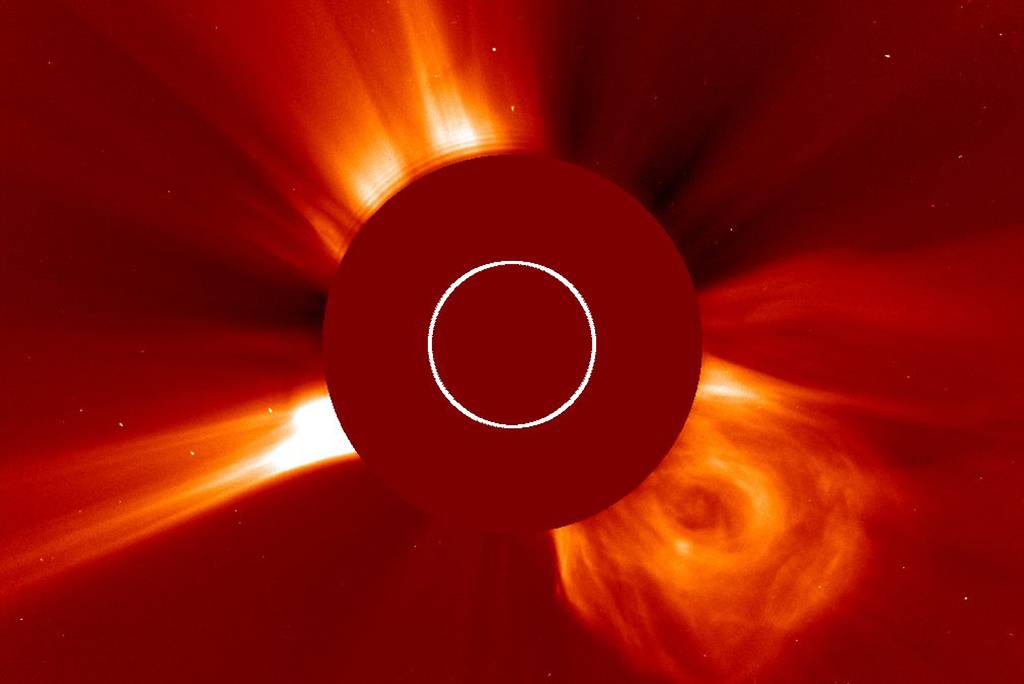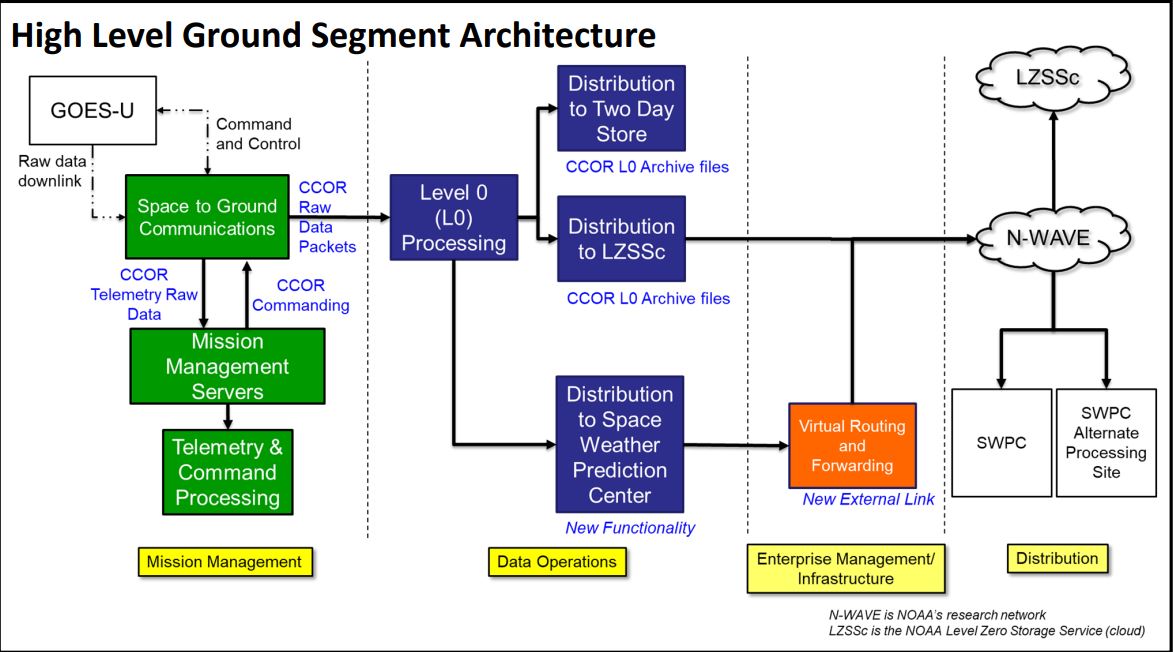 An image of the sun taken by the GOES-16 Solar Ultraviolet Imager on April 29, 2024. (Source: NOAA)
An image of the sun taken by the GOES-16 Solar Ultraviolet Imager on April 29, 2024. (Source: NOAA)
ALEXANDRIA, Va. — Solar weather often feels like a ghost threat—an unseen, unexpected occurrence that can result in destruction across ground infrastructure and satellite constellations. The upcoming launch of a new Geostationary Operational Environmental Satellite (GOES-U) is part of an effort by the U.S. National Oceanic and Atmospheric Administration (NOAA) to more accurately observe and forecast solar weather.
Ahead of the scheduled June 25 launch of GOES-U, Constellations spoke with Pam Sullivan, GOES Program Director at NOAA, who emphasized the widespread benefit of the satellite program for Earth and space-based applications. “The billion people that live in the Western Hemisphere will really benefit,” Sullivan said. “We’re very excited for the upcoming launch.”
While GOES may be best-known as an Earth-observing constellation focused on atmospheric research and terrestrial weather, GOES-U will bring an upgraded suite of sensors customized for detecting and characterizing geomagnetic storms that could wreak havoc on Earth and space-based critical infrastructure.
The Trillion-Dollar Disaster
Earlier this year, NOAA satellites detected a severe solar event that triggered a G4-class geomagnetic storm. In 2022, Starlink lost 39 satellites following a geomagnetic storm only half as severe—a moderate G2-class storm caused by a coronal mass ejection (CME) from the northeast quadrant of the Sun. The density of the atmosphere increased significantly due to the solar storm, and the satellites were unable to safely reach orbit.
“Living with a star is dangerous,” said Sullivan. “If there’s more energy coming from the sun, that tends to raise the [density of the] atmosphere. And so the drag on low Earth satellites changes, and they’re more likely to come down faster.”
Solar flares will continue to impact satellite systems, the power grid and even software, especially as LEO becomes more accessible and satellite launches continue to accelerate. A severe, unexpected geomagnetic storm could potentially lead to a devastating loss of access to critical space-based communications, position, navigation and timing, Earth observation and more.
 Visible light emission from the sun shows a coronal mass ejection. (Source: NOAA)
Visible light emission from the sun shows a coronal mass ejection. (Source: NOAA)
The damage will not be limited to space, either. The first ever observed CME, the Carrington Event, was also the most intense geomagnetic storm in recorded history. It peaked on September 1-2, 1859, and resulted in auroras visible in the tropics, severe damage to telegraph stations and reports of telegraph lines going up in flames.
A similar event today would likely result in major destruction to the electrical grid, as well as disruptions to telecommunications, financial markets, emergency and hospital services and potentially yearslong power outages. “A severe space weather event could be the world’s first trillion-dollar disaster,” said Sullivan. “If a CME caused large-scale damage to the North American electrical grid, the losses have been estimated at $40 billion a day.”
Understanding the origins of these solar events is vital to protecting these systems, as well as reacting appropriately when damage does occur. “Space weather effects can sometimes look like bad actors,” Sullivan said. “It’s important to know if a natural phenomenon is causing something to malfunction, as opposed to terrorist or criminal activity.” Because it can be difficult to distinguish between cyber threat actors and space weather events on the ground, it is critically important to have correct information when handling failures.
Keeping an Eye on the Sun
Solar monitoring instruments such as coronagraphs are vital to monitoring large-scale solar weather events like CMEs. The upcoming launch of GOES-U will include the Compact Coronagraph (CCOR-1), an instrument developed at the Naval Research Laboratory that will give new insights to assess and prepare for the potential impacts of solar storms on infrastructure in space or on Earth.
GOES-U is set to replace the only coronagraph currently flying, the Large Angle and Spectrometric Coronagraph (LASCO), which was launched in 1995 onboard the ESA-NASA satellite SOHO. The GOES program requires two operational satellites, one East and one West, to maintain visual coverage of the entire country as well as the adjacent oceans. The GOES-U satellite will replace the currently flying GOES-East satellite.
“It will be the first time there’s actually an operational coronagraph being used for space weather forecasting,” Sullivan said. “It’s looking for mass ejections that are coming from the sun, and it’s trying to figure out which direction they’re going.”
CCOR-1 will image the outer layer of the sun’s atmosphere using a compact telescope that blocks the main disc of the Sun in order to make the corona, where many extreme space weather events originate, visible. Improvements in CCOR-1 will enable image delivery within 30 minutes of acquisition, compared to up to eight hours to deliver images from LASCO, supporting geomagnetic storm prediction up to one day in advance.
The CCOR will collect images of the sun’s coronal white light that can be analyzed to determine the size, velocity and density of CMEs. CCOR is also half the size of a traditional coronagraph, leaving plenty of available size, weight and power for the six other instruments onboard GOES-U.
Accurate solar weather measurements will make life on Earth and in space safer for everybody. Solar weather “affects things that people care about,” Sullivan said, “like astronauts that are orbiting in the space station, and radio and GPS signals, and the electrical grid.”
A second coronagraph, aboard NOAA’s Space Weather Follow On Lagrange 1 (SWFO-L1) satellite, will be sent with a NASA probe, IMAP, scheduled to launch in 2025. That instrument will observe the sun from the Sun-Earth Lagrange 1 point (L1), which will allow for longer lead time on potential solar flares and CMEs.
Data Relay and the Future of Weather Satellites
NOAA is moving to the use of the cloud for data distribution. This will make data access cheap and widespread, and will allow weather data updates every few minutes. Future data delivery processes will make all data products directly available to anyone with access to the cloud—not just large organizations with an RF dish.
“I can only imagine a small fraction of what people will do [with the data],” Sullivan said. “The more you make the data available to people, the more widespread the use will be.” This new system will allow users to selectively receive the specific data that matters to them, and will make data access cheap, easy and widespread. “It’s not quite like the invention of the printing press,” Sullivan said, “but it’s in that category.”
 GOES-U will distribute data through the Space Weather Prediction Center. (Source: NOAA)
GOES-U will distribute data through the Space Weather Prediction Center. (Source: NOAA)
The GOES-U satellite is expected to be operational into the 2030s, about the time NOAA is planning to transition to the GeoXO satellite program. GeoXO is the scheduled follow-on to the GOES program that will launch in 2032. The GeoXO program is meant to expand observations of emerging environmental issues such as climate change by adding advanced observation capabilities and new atmospheric and ocean measurements.
GeoXO is primed to work closely with industry via new contracts to build the instruments aboard the satellites. Several contracts have already been awarded; the imager will be built by L3Harris, while the sounder will be built by Ball Aerospace. Contracts for three more observation instruments remain in competition: the lightning mapper, atmospheric composition, and ocean color. The spacecraft contract is expected to be rewarded in the next six months.
Explore More:
Podcast: Space Research Pre-NASA and the Next Generation of Scientists
In New Moonshot, Commercial Space Is Focused on Infrastructure
Report: Commercial Partnerships, Lunar Initiatives Driving Space Exploration Budgets
Space Executive Explains Growth Trends for Value-Added Space Services
